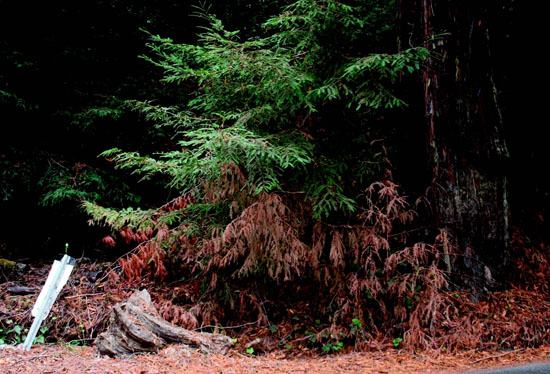|
|
Published December 2nd, 2015
|
Recent Rain Small Respite for Drought-Stressed Trees
|
|
| By Chris Lavin |
 |
| Photo Chris Lavin |
Mother Nature has been a tease. One good rainstorm - even a few claps of thunder - and she figures that is enough. She is even going to give us a few more little showers in the next couple of weeks, but after four years of holding back, it is of little use to thousands of our most adored neighbors: the trees.
 "Four years is a long time," said Kenny Murakami, who runs the Moraga Garden Center. "I think all the trees are hurting."
"Four years is a long time," said Kenny Murakami, who runs the Moraga Garden Center. "I think all the trees are hurting."
 Usually by conventional standards, rainy season starts Oct. 1. But for the past four years, Mother Nature has turned her back on the calendar and crossed her arms with a huff. The brief showers that have been teasing the landscape here and there have not even begun to make a dent in the drought that has hit Northern California, and it is evidenced in the extreme stress on Lamorinda trees.
Usually by conventional standards, rainy season starts Oct. 1. But for the past four years, Mother Nature has turned her back on the calendar and crossed her arms with a huff. The brief showers that have been teasing the landscape here and there have not even begun to make a dent in the drought that has hit Northern California, and it is evidenced in the extreme stress on Lamorinda trees.
 "I've never seen such mortality," said Mark Silva, a ranger with the East Bay Municipal Utility District. "We're seeing dead trees everywhere. I've never seen anything like it."
"I've never seen such mortality," said Mark Silva, a ranger with the East Bay Municipal Utility District. "We're seeing dead trees everywhere. I've never seen anything like it."
 Whether in yards or parks or natural areas throughout our neighborhoods, trees are showing signs of significant stress. Many have died, others are moving toward the nursing home. More dead branches are falling, more needles are raining down, and arborists are busy trimming branches and felling dead trees.
Whether in yards or parks or natural areas throughout our neighborhoods, trees are showing signs of significant stress. Many have died, others are moving toward the nursing home. More dead branches are falling, more needles are raining down, and arborists are busy trimming branches and felling dead trees.
 "It (the drought) is definitely not good for the trees," said Abby Bill, a nursery worker at Moraga Garden Center.
"It (the drought) is definitely not good for the trees," said Abby Bill, a nursery worker at Moraga Garden Center.
 "They're just having a harder time reaching down to the water table," her boss Murakami said.
"They're just having a harder time reaching down to the water table," her boss Murakami said.
 Dead and dying trees are not only a fire hazard, but a blight on the landscape. Wetter weather that might or might not be coming could ameliorate fires. Yet homeowners with a beloved tree - and mandatory restrictions on water use - are wringing their hands over some of their favorites, and have them considering gray-water systems and more to conserve water to feed the trees.
Dead and dying trees are not only a fire hazard, but a blight on the landscape. Wetter weather that might or might not be coming could ameliorate fires. Yet homeowners with a beloved tree - and mandatory restrictions on water use - are wringing their hands over some of their favorites, and have them considering gray-water systems and more to conserve water to feed the trees.
 "I think people are trying to figure out a lot of things," Bill said. "No one wants to see this."
"I think people are trying to figure out a lot of things," Bill said. "No one wants to see this."
 So far this year, the Lamorinda area has received about 1.5 inches of rain. The average, adult live oak tree drinks 20 to 30 gallons of water per day, and its roots are relatively shallow - they spread out as wide as their canopies. Some homeowners have taken to installing drip systems around their trees to enhance the natural flow from the sky.
So far this year, the Lamorinda area has received about 1.5 inches of rain. The average, adult live oak tree drinks 20 to 30 gallons of water per day, and its roots are relatively shallow - they spread out as wide as their canopies. Some homeowners have taken to installing drip systems around their trees to enhance the natural flow from the sky.
 And while estimates vary, redwoods slurp up as much as 300 gallons a day, which then transpires off into the atmosphere. (Their roots go deeper than oaks.) Recently scientists such as Steve Sillett of Humbolt State University and Todd Dawson of University of California-Berkeley have found that redwoods also suck up as much as 40 percent of their water from fog during the dry months. After all, carrying hydration from the water table up 20-or-so stories isn't all that easy. But alas, it turns out that redwoods can take in the fog directly through their bark and needles.
And while estimates vary, redwoods slurp up as much as 300 gallons a day, which then transpires off into the atmosphere. (Their roots go deeper than oaks.) Recently scientists such as Steve Sillett of Humbolt State University and Todd Dawson of University of California-Berkeley have found that redwoods also suck up as much as 40 percent of their water from fog during the dry months. After all, carrying hydration from the water table up 20-or-so stories isn't all that easy. But alas, it turns out that redwoods can take in the fog directly through their bark and needles.
 If only there was more fog. So far, Mother Nature has said nix on that, mostly, too.
If only there was more fog. So far, Mother Nature has said nix on that, mostly, too.


|
|
|
|
|
 Ways to Protect Your Trees Ways to Protect Your Trees

 Before the rains start in earnest - if they do indeed start and stay in earnest - homeowners have various ways of helping their stressed-out trees that have been suffering from the four-year drought. Yet, there are problems besides lack of water. Before the rains start in earnest - if they do indeed start and stay in earnest - homeowners have various ways of helping their stressed-out trees that have been suffering from the four-year drought. Yet, there are problems besides lack of water.
 One: Many homeowners have planted trees with high water requirements. "Trees planted with high water needs such as magnolias, weeping birches and other non-native trees have been planted in areas, particularly lawns, that are now not receiving water or in areas with inadequate irrigation," said Lorie Edwards of Advance Tree. One: Many homeowners have planted trees with high water requirements. "Trees planted with high water needs such as magnolias, weeping birches and other non-native trees have been planted in areas, particularly lawns, that are now not receiving water or in areas with inadequate irrigation," said Lorie Edwards of Advance Tree.
 Two: People are still spraying their gardens with hoses. Two: People are still spraying their gardens with hoses.
 It's kind of a Vegas craps game to see which species will recover. Birches are weeping, willows are shedding their skins like birches. And while a wagging finger can say the homeowner is at fault for planting a non-native, it is not just the non-natives that are suffering. "Even our native trees that are used to our annual summer drought can suffer because of this extended drought," Edwards said. It's kind of a Vegas craps game to see which species will recover. Birches are weeping, willows are shedding their skins like birches. And while a wagging finger can say the homeowner is at fault for planting a non-native, it is not just the non-natives that are suffering. "Even our native trees that are used to our annual summer drought can suffer because of this extended drought," Edwards said.
 Stressed-out trees are also more susceptible to diseases and pests, she said. Edwards recommends what arborists and landscapers say, too. "The remedy is obviously to increase the water to these trees," she wrote by email. "One method is to use a deep-root irrigation device." That means, yes, burying it under dirt and mulch and giving it a regular squirt through the household system, metered through EBMUD. Stressed-out trees are also more susceptible to diseases and pests, she said. Edwards recommends what arborists and landscapers say, too. "The remedy is obviously to increase the water to these trees," she wrote by email. "One method is to use a deep-root irrigation device." That means, yes, burying it under dirt and mulch and giving it a regular squirt through the household system, metered through EBMUD.
 Another is to mulch and mulch. Do not, according to arborists, just lay your drip line on the ground. Pile some mulch over it. So dig down, put your drip in, then set a timer. Another is to mulch and mulch. Do not, according to arborists, just lay your drip line on the ground. Pile some mulch over it. So dig down, put your drip in, then set a timer.
 And a lot of love won't hurt, either. And a lot of love won't hurt, either. |
|
|
|
|





